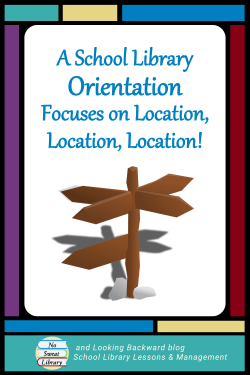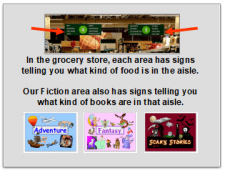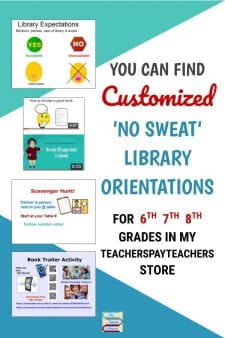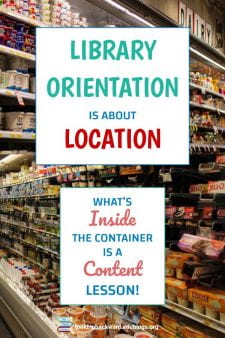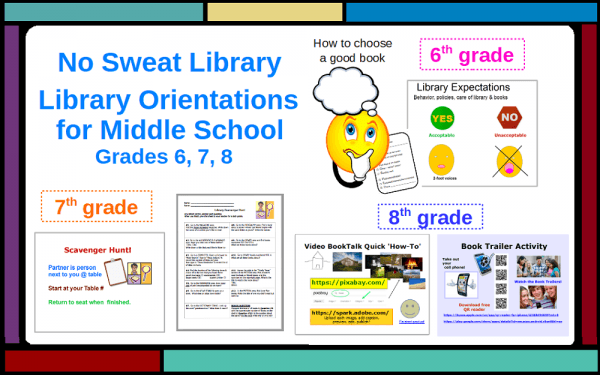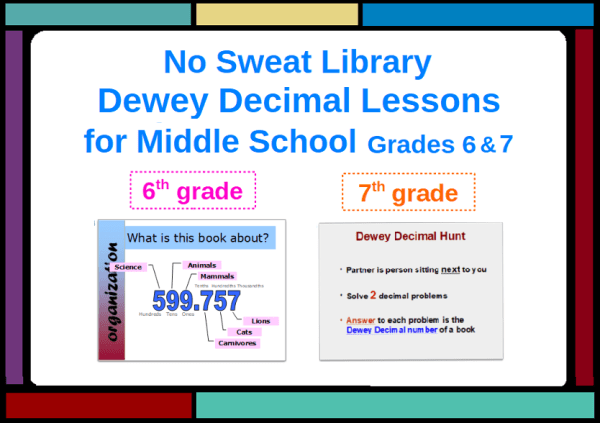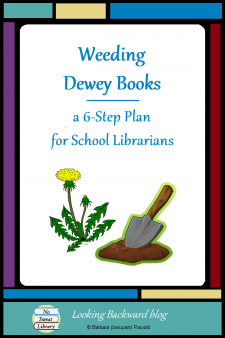 There’s no one way to weed—much depends on your grade level and curriculum, your students, and which part of the collection is to be weeded. Weeding Dewey books generates the most questions on my listservs, so I’ll share my experience hoping that it makes your task easier and reassures you that what remains is useful and enjoyable for your students.
There’s no one way to weed—much depends on your grade level and curriculum, your students, and which part of the collection is to be weeded. Weeding Dewey books generates the most questions on my listservs, so I’ll share my experience hoping that it makes your task easier and reassures you that what remains is useful and enjoyable for your students.
Your first inclination may be to run a report for never circulated books, but don’t. I did that my first time, but as I pulled books off the shelf, I realized they aren’t old, they’re invisible to students because they’re crammed in with truly old or unappealing books that circulated in the past, so they don’t appear on the report! After thinking about the problem, I came up with a new 6-Step Dewey Weeding Plan.
STEP 1: REMOVE OUTDATED/OLD BOOKS
First remove everything with a publication date older than the past 4-6 years, except for sections which never get “old” like 200 religion, 398 folktales, 800s literature, and those always-popular topics. This alone can remove up to 30% of your Dewey books, with the biggest weeds coming from the 300s, 500s, 600s, and 900s which all get old pretty fast. It’s amazing how much better the shelves look and how much easier it is to spot “interesting” books after doing this initial weeding.
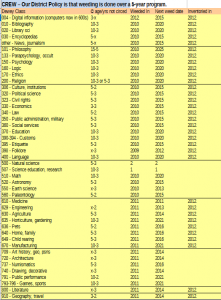 At left is a helpful list I found for weeding Dewey numbers, made into a chart that also has columns for when each Dewey Class is weeded, when to weed it next, and when it’s inventoried.
At left is a helpful list I found for weeding Dewey numbers, made into a chart that also has columns for when each Dewey Class is weeded, when to weed it next, and when it’s inventoried.
After initial weeding, it’s tempting to keep some “old” books, thinking kids might still use them, but check the circulation stats: if the book wasn’t checked out at least 10 times in the past couple years, it doesn’t interest students; if it was, it’s a popular topic and you need to purchase more current books.
STEP 2: DETERMINE POPULAR TOPICS
Wondering how to determine popular topics? Circulation statistics can help, but it’s even better to use our own students! Invite a dozen or so kids from different grade levels, including some that aren’t usually library users, to a breakfast or lunch meeting. (If you’re new to the school, ask teachers to help choose students. It’s good PR to show that you invite input!)
Tell students you need their help to determine Dewey books they like to read and give them plenty of time to browse the now-thinned shelves to pick out a dozen books that interest them. By the end of the meeting you’ll end up with ~150 books on popular topics for incidental reading. These are the Dewey numbers you can weed less rigorously and you may even decide to put back a few of those older books you already weeded.
STEP 3: REMOVE NON-CURRICULAR BOOKS
Get rid of books that do not match Subject Content Standards, especially for research projects. Even if you think they’re “great titles” they won’t be used if they don’t fit your school’s curriculum. Don’t hang on to books “we used to use for research.” Curriculum changes may bring the topic back, but probably not sooner than 5-7 years, and by that time those books will be outdated.
For example, I removed all books about U.S. States except our own because middle school only studies our own (if needed, more current information is available online). I did keep books about cultural/ethnic/racial groups, books about events in U.S. History, and books about national parks or wonders, but I redid their Dewey numbers and kids began to check them out:
- Geography, Natural Wonders, and Landmarks books are 973.091, where .091 is from DDC Table 1 Geographic Treatment.
- Events, like western settlement and 9/11, were put into the time period in which they happened, from 973.1 through 973.9.
STEP 4: REMOVE BOOKS WITH ONLINE SOURCES
We typically choose online databases for curriculum-related topics that need to be current. For those topics it’s better for students to use the online resources, so weed these books ruthlessly!
Take a good look at your 900s. Country books get old fast, so if you have database subscriptions of countries, you don’t need country data & stats books. Keep topical books, such as national parks and natural wonders, cultural titles that highlight particular cities or peoples, and significant national events, especially if these books have lots of colorful pictures. Get rid of everything else—pare it down to a single section for each continent with only 2-3 shelves each. I guarantee your students will check out these “interesting” books like crazy once the “clutter” is gone.
A kid-friendly suggestion: I moved 980-990 books over to shelves next to 971 Canada & 972 Middle America books so all non-U.S. countries are along a single aisle of shelves. The sign at the end of the aisle has “Countries of the World”—the sign for the other side is “U.S. History”—and a small sign on the 972 shelf states the 973s are in the next aisle. Frankly, most kids don’t even realize there’s a gap—they just love browsing all the “other country” books in a single area! (If you are not a U.S. school library, I suspect the section of your own country books is huge compared to other-country books and a similar strategy will work for your students, too.)
STEP 5: REMOVE NEVER CIRCULATED BOOKS
Finally, weed unpopular and non-curricular titles that were never checked out, knowing no one will miss these books. If in doubt, my criteria for deciding was, if I wouldn’t read it, neither will a kid! The exception is books that students may enjoy if they’re shelved in another location with topically-related books.
STEP 6: CHANGE DEWEY NUMBERS FOR ACCESS
As I was weeding ‘never circulated’ items I came across many books that would be more noticed at a different location, so I changed the Dewey Call Numbers. I don’t see this as a problem, but rather as a solution. The whole purpose of DDC is “works that are used together to be found together” and our library ‘users’ are quite different from LOC or public library users. Here are examples of the larger changes I made so students could find books more easily.
- BOY BOOKS:
- Pirate and shipwreck books are popular with middle school boys, so I pulled all the pirate books from other areas and added them to 910.4. I also added books on explorers and exploration & discovery to 910.9, so the “Adventure” shelf became very popular—I got several comments about all the “new” pirate books!

- Military books in 355-359 are boy favorites, but books on military vehicles were invisible among car books in the 620s. I changed their Dewey numbers to 355.8 and they were quickly checked out.
- Books on various types of buildings are in 300s, 600s, 700s (architecture), and even 900s (pyramids). I brought them all together into 690 Buildings—the last shelf of the 600s. Mine was at the end of an aisle, and that shelf became perpetually empty because books that had never before circulated were constantly being noticed and checked out…so I purchased lots of new ones!
linebreak
- Pirate and shipwreck books are popular with middle school boys, so I pulled all the pirate books from other areas and added them to 910.4. I also added books on explorers and exploration & discovery to 910.9, so the “Adventure” shelf became very popular—I got several comments about all the “new” pirate books!
- COMPUTER books are scattered from 003 through the 700s, making it nearly impossible to “browse” the topic. I pulled everything together to 621.38 and 621.39 and immediately had increased checkouts.

- In the 973 U.S. HISTORY section I also changed books about the 13 original colonies to 973.2 with their 2-letter postal code instead of author letters. You can read more about this in my post How to Support Content Reading in Social Studies.
A SATISFIED COMPLETION
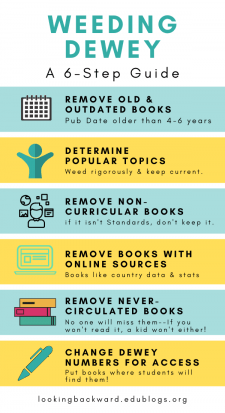 My library director always said, “It’s better to have a small collection of books that are read, than a huge collection of those that aren’t.” My first intensive weeding confirmed that: getting rid of uninteresting books helps kids find really interesting ones they want to read; getting multiple copies of popular topics means more students read more books; and having a substantially decreased collection actually increases circulation!
My library director always said, “It’s better to have a small collection of books that are read, than a huge collection of those that aren’t.” My first intensive weeding confirmed that: getting rid of uninteresting books helps kids find really interesting ones they want to read; getting multiple copies of popular topics means more students read more books; and having a substantially decreased collection actually increases circulation!
Now I rarely do a whole-collection inventory; each year I weed certain Dewey Classes, so I complete enough to do the entire collection within 5 years. I simply weed as I shelve books. Using my weeding chart and a diagram of my bookshelves, I print the scheduled shelves and tape the diagram to a bookcart. As I put books on a scheduled shelf, I take a few extra minutes to weed the shelf, then cross it off the diagram. When all shelves on the diagram are done, I record it in my digital documents, then print the next scheduled section.
![]()


